Question
(a) Chlorobenzene and phenol both show a lack of reactivity towards reactants that cause the breaking of the C–X bond (X = Cl or OH).
Explain why.
(b) When phenol is reacted with bromine dissolved in an inert solvent, two isomeric bromophenols, C6H4BrOH, are formed.
Suggest structures for these products. Name each compound.
(c) A student suggested that phenol can be prepared from benzene by the method shown.
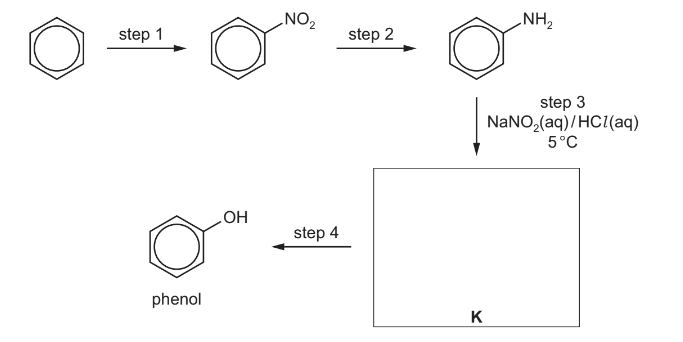
step 4 ___________________________________
(ii) Deduce the structure for K and draw its structural formula in the box.
(iii) Name the mechanism for step 1.
(iv) Write an equation for step 2. Use [H] for the reducing agent in this equation.
Answer/Explanation
Answer: (a) M1 C-X / C-Cl / C-O bond is stronger (in chlorobenzene / phenol) [1]
M2 p-orbital / lone pair on Cl / O(H) / X (in chlorobenzene / phenol) [1]
M3 electrons of the (Cl / O / electronegative atom) AND overlap / delocalise with π-electron cloud / delocalise into ring [1]
(b)
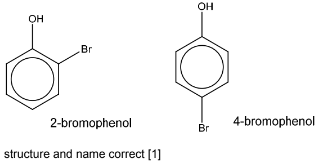
(c)(i) step 1 conc. HNO3 + H2SO4 (and temperare 50–55 °C) [1]
step 2 Sn + HCl AND one of conc.HCl + heat [1]
step 4 H2O warm / heat [1]
(c)(ii)

(c)(iii) step 1 electrophilic substitution
(c)(iv) C6H5NO2 + 6[H] → C6H5NH2 + 2H2O
Question
(a) An aldehyde, an alkane and a carboxylic acid, all of similar volatility, are mixed together. The mixture is then analysed in a gas chromatograph.
The gas chromatogram produced is shown.
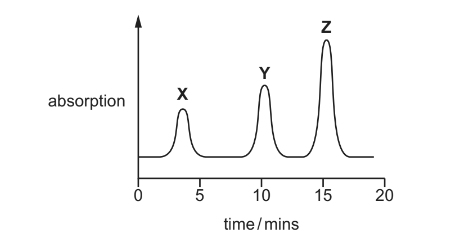
The separation of the compounds depends on their relative solubilities in the stationary phase.
The stationary phase is a liquid alcohol.
(i) Complete the table to suggest which compound in the mixture is responsible for each peak X, Y and Z. Explain your answer by reference to the intermolecular forces of the compounds.
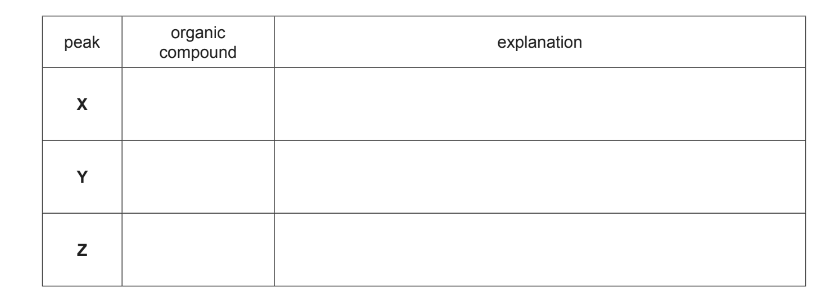
(ii) A student calculates the areas underneath the three peaks in the chromatogram.

The area underneath each peak is proportional to the mass of the respective compound.
Calculate the percentage by mass in the original mixture of the compound responsible for peak Z.
(b) (i) The mass spectrum of a halogenoalkane containing one chlorine atom or bromine atom will show an additional peak at M+2.
State the isotopes of chlorine and bromine responsible for M+2 peaks.
(ii) The mass spectrum of bromochloromethane, CH2BrCl, has a molecular ion peak, M, at an m/e value of 128. It also has M+2 and M+4 peaks.
Suggest the identity of the molecular ions that give rise to these peaks.
(c) Halogenoalkanes can be formed from the reaction of an alkene with a hydrogen halide. Methylpropene reacts with hydrogen bromide to form 2-bromo-2-methylpropane.

(i) Draw the mechanism of this reaction. Include all relevant curly arrows, dipoles and charges.
(ii) 1-bromo-2-methylpropane is also formed in this reaction.
Explain why 2-bromo-2-methylpropane will be the major product in this reaction.
(d) (i) Explain what is meant by the term partition coefficient, Kpartition.
(ii) The partition coefficient of organic compound H between dichloromethane and water is 4.75.
● 2.50g of compound H was dissolved in water and made up to 100cm3 in a volumetric flask.
● 50cm3 of this aqueous solution were shaken with 10cm3 of dichloromethane.
Calculate the mass of compound H that was extracted into the dichloromethane.
Answer/Explanation
Answer: (a)(i)
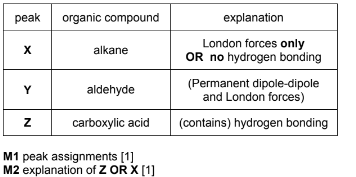
(a)(ii) % of Z = 47/98 = 48%
(b)(i) 37Cl and 81Br
(b)(ii) M peak CH235Cl79Br
M+2 peak CH237Cl79Br OR CH235Cl81Br M+4 peak CH237Cl81Br
two correct scores 1 mark
all 3 correct scores 2 marks
(c)(i)

(c)(ii) (major product is) formed via the most stable tertiary carbocation / intermediate
OR tertiary halogenoalkane formed via more stable carbocation / intermediate
(d)(i) M1 ratio of the concentrations of solute in two (immiscible) solvents [1]
M2 at equilibrium [1]
(d)(ii) Kpartition = (x/10)/(1.25-x/50) [1]
4.75(1.25-x) = 5x
x = 5.9375/9.75 = 0.61 g [1]